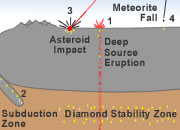Home » General Geology » Divisions of Geologic Time
Divisions of Geologic Time
Major Chronostratigraphic and Geochronologic Units
Republished from a July 2010 Fact Sheet by the United States Geological Survey.

Geologic Time Scale: Divisions of Geologic Time approved by the U.S. Geological Survey Geologic Names Committee, 2010. The chart
shows major chronostratigraphic and geochronologic units. It reflects ratified unit names and boundary estimates
from the International Commission on Stratigraphy (Ogg, 2009). Map symbols are in parentheses.
* Changes to the time scale since March 2007 (see text).
** The Ediacaran is the only formal system in the Proterozoic with a global boundary stratotype section and point (GSSP). All other units are periods.
Source: USGS Fact Sheet. URL: https://pubs.usgs.gov/fs/2010/3059/
Introduction
Effective communication in the geosciences requires consistent uses of stratigraphic nomenclature, especially divisions of geologic time. A geologic time scale is composed of standard stratigraphic divisions based on rock sequences and is calibrated in years (Harland and others, 1982). Over the years, the development of new dating methods and the refinement of previous methods have stimulated revisions to geologic time scales.
Advances in stratigraphy and geochronology require that any time scale be periodically updated. Therefore, Divisions of Geologic Time, which shows the major chronostratigraphic (position) and geochronologic (time) units, is intended to be a dynamic resource that will be modified to include accepted changes of unit names and boundary age estimates.
Since the mid-1990s, geologists from the U.S. Geological Survey (USGS), State geological surveys, academia, and other organizations have sought to create a consistent time scale to be used in communicating ages of geologic units in the United States. Many international debates have occurred over names and boundaries of units, and various time scales have been used by the geoscience community.
New Time Scale
Since publication of a chart showing divisions of geologic time in the seventh edition of the USGS guide Suggestions to Authors (Hansen, 1991), no other time scale has been officially endorsed by the USGS. For consistent usage of time terms, the USGS Geologic Names Committee (GNC; see box for members) and the Association of American State Geologists (AASG) developed Divisions of Geologic Time (fig. 1), which represents an update containing the unit names and boundary age estimates ratified by the International Commission on Stratigraphy (ICS). Scientists should note that other published time scales may be used, provided that these are specified and referenced (for example, Palmer, 1983; Harland and others, 1990; Haq and Eysinga, 1998; Gradstein and others, 2004; Ogg and others, 2008).
Advances in stratigraphy and geochronology require that any time scale be periodically updated. Therefore, Divisions of Geologic Time (fig. 1) is intended to be a dynamic resource that will be modified to include accepted changes of unit names and boundary age estimates. This fact sheet is a modification of USGS Fact Sheet 2007-3015 by the U.S. Geological Survey Geologic Names Committee (2007).
Divisions of Geologic Time shows the major chronostratigraphic (position) and geochronologic (time) units; that is, eonothem/eon to series/epoch divisions. Scientists should refer to the ICS time scale (Ogg, 2009) and resources on the National Geologic Map Database Web site (https://ngmdb.usgs.gov/Info/standards/) for stage/age terms. Most systems of the Paleozoic and Mesozoic are subdivided into series using the terms "Lower," "Middle," and "Upper." The geochronologic counterpart terms for subdivisions of periods are "Early," "Middle," and "Late." The international geoscience community is applying names to these subdivisions based on stratigraphic sections at specific localities worldwide. All series/epochs of the Silurian and Permian systems have been named, and although usage of these names is preferred, "lower/early," "middle," and "upper/late" are still acceptable as informal units (lowercase) for these two systems/periods.
In the ICS time scale, the uppermost part of the Cambrian has been named "Furongian" and the lowermost part the "Terreneuvian." The GNC, however, will not include these names in the Divisions of Geologic Time until all series/epochs of the Cambrian are named.
Cenozoic
A controversial issue during the first decade of the 21st century was the position of the base of the Quaternary System/Period and its status as a formal division of time. After much debate, the International Union of Geological Sciences formally ratified a new definition of the base of the Quaternary and the corresponding base of the Pleistocene Series/Epoch, changing its age from 1.806 Ma to 2.588 Ma (see box for age terms) (Gibbard and others, 2010). This is a major change from the 2007 time scale (U.S. Geological Survey Geologic Names Committee, 2007) and the one published in Hansen (1991). Although the Tertiary is not recognized by many international time scales, the GNC agrees that it is important that it be recognized as a system/period; the map symbols "T" (Tertiary) and "Q" (Quaternary) have been used on geologic maps for more than a century and are widely used today.
Another change to the time scale is the age of the base of the Holocene Series/Epoch. The boundary is now defined on the basis of an abrupt climate change recorded by indicators in a Greenland ice core (Walker and others, 2009). The Pleistocene-Holocene boundary is dated at 11,700 calendar years before A.D. 2000.
Precambrian
For many years, the term "Precambrian" was used for the division of time older than the Phanerozoic. For consistency with the time scale in Hansen (1991), the term "Precambrian" is considered to be informal and without specific stratigraphic rank (although it is here capitalized). Also of note, the Ediacaran is the only formal system in the Proterozoic. All other units are periods until global boundary stratotype sections or points are defined.
| Printable Time Scale |
Get a simplified geologic time scale for student or reference use. Saved as a .pdf document for easy printing at https://geology.com/time.htm
| Age Terms |
The age of a stratigraphic unit or the time of a geologic event may be expressed in years before present (before A.D. 1950). The "North American Stratigraphic Code" (North American Commission on Stratigraphic Nomenclature, 2005) recommends abbreviations for ages in SI (International System of Units) prefixes coupled with "a" for "annum": ka for kilo-annum (103 years); Ma for mega-annum (106 years); and Ga for giga-annum (109 years). Duration of time should be expressed in millions of years (m.y.); for example, "deposition began at 85 Ma and continued for 2 m.y."
Map colors
Color schemes for geologic maps are based on standards related to the time scale. Two principal color schemes are used, one by the Commission for the Geologic Map of the World (CGMW) and another by the USGS. Colors typically shown on USGS geologic maps have been used in a standard fashion since the late 1800s and recently have been published in the Federal Geographic Data Committee (FGDC) digital cartographic standard for geologic map symbolization (Federal Geographic Data Committee, Geologic Data Subcommittee, 2006). The GNC decided in 2006 that the USGS colors should be used for large-scale and regional geologic maps of the United States. For international maps or small-scale maps (for instance, 1:5 million) of the United States or North America, the GNC recommends use of the international (CGMW) colors. Specifications for the USGS colors are in the Federal Geographic Data Committee, Geologic Data Subcommittee (2006) guide, and those for the CGMW colors are in Gradstein and others (2004).
| References Cited |
Federal Geographic Data Committee, Geologic Data Subcommittee, 2006, FGDC digital cartographic standard for geologic map symbolization: Federal Geographic Data Committee Document Number FGDC-STD-013-2006, 290 p., 2 pls., available online at https://ngmdb.usgs.gov/fgdc_gds/.
Gibbard, P.L., Head, M.J., Walker, J.C., and the Subcommission on Quaternary Stratigraphy, 2010, Formal ratification of the Quaternary System/Period and the Pleistocene Series/Epoch with a base at 2.58 Ma: Journal of Quaternary Science, v. 25, p. 96-102.
Gradstein, Felix, Ogg, James, and Smith, Alan, eds., 2004, A geologic time scale 2004: Cambridge, U.K., Cambridge University Press, 589 p., 1 pl.
Hansen, W.R., ed., 1991, Suggestions to authors of the reports of the United States Geological Survey, seventh edition: Reston, Va., U.S. Geological Survey, 289 p.
Haq, B.U., and Eysinga, F.W.B., van, eds., 1998, Geological time table (5th ed.): Amsterdam, Elsevier, 1 sheet.
Harland, W.B., Armstrong, R.L., Cox, A.V., Craig, L.E., Smith, A.G., and Smith, D.G., 1990, A geologic time scale, 1989: Cambridge, U.K., Cambridge University Press, 263 p.
Harland, W.B., Cox, A.V., Llewellyn, P.G., Picton, C.A.G., Smith, A.G., and Walters, R.W., 1982, A geologic time scale: Cambridge, U.K., Cambridge University Press, 131 p.
North American Commission on Stratigraphic Nomenclature, 2005, North American stratigraphic code: American Association of Petroleum Geologists Bulletin, v. 89, p. 1547-1591. (Also available at https://ngmdb.usgs.gov/Info/NACSN/Code2/code2.html.)
Ogg, Gabi, comp., 2009, Global boundary stratotype sections and points (GSSP): International Commission on Stratigraphy, accessed May 10, 2010, at http://stratigraphy.science.purdue.edu/gssp/. (As of September 2022, this material can be accessed at https://timescalefoundation.org/gssp/.)
Ogg, J.G., Ogg, Gabi, and Gradstein, F.M., 2008, The concise geologic time scale: Cambridge, U.K., Cambridge University Press, 177 p.
Palmer, A.R., comp., 1983, The Decade of North American Geology [DNAG] 1983 geologic time scale: Geology, v. 11, p. 503-504.
U.S. Geological Survey Geologic Names Committee, 2007, Divisions of geologic time-major chronostratigraphic and geochronologic units: U.S. Geological Survey Fact Sheet 2007-3015, 2 p.
Walker, Mike, Johnsen, Sigfus, Rasmussen, S.O., and others, 2009, Formal definition and dating of the GSSP (global stratotype section and point) for the base of the Holocene using the Greenland NGRIP ice core, and selected auxiliary records: Journal of Quaternary Science, v. 24, p. 3-17.
| Members of the Geologic Names Committee |
Randall C. Orndorff (chair), Nancy Stamm (recording secretary), Steven Craigg, Lucy Edwards, David Fullerton, Bonnie Murchey, Leslie Ruppert, David Soller (all USGS), and Berry (Nick) Tew, Jr. (State Geologist of Alabama).
| More General Geology |
 |
Gifts That Rock |
 |
Diamonds from Coal? |
 |
What is a Geyser? |
 |
The Doorway to Hell |
 |
What is the San Andreas Fault? |
 |
Igneous and Volcanic Features |
 |
Spectacular Fossils |
 |
Bubbles in Amber |

Find Other Topics on Geology.com:

|

| ||

|

| ||

|

| ||

|

|
